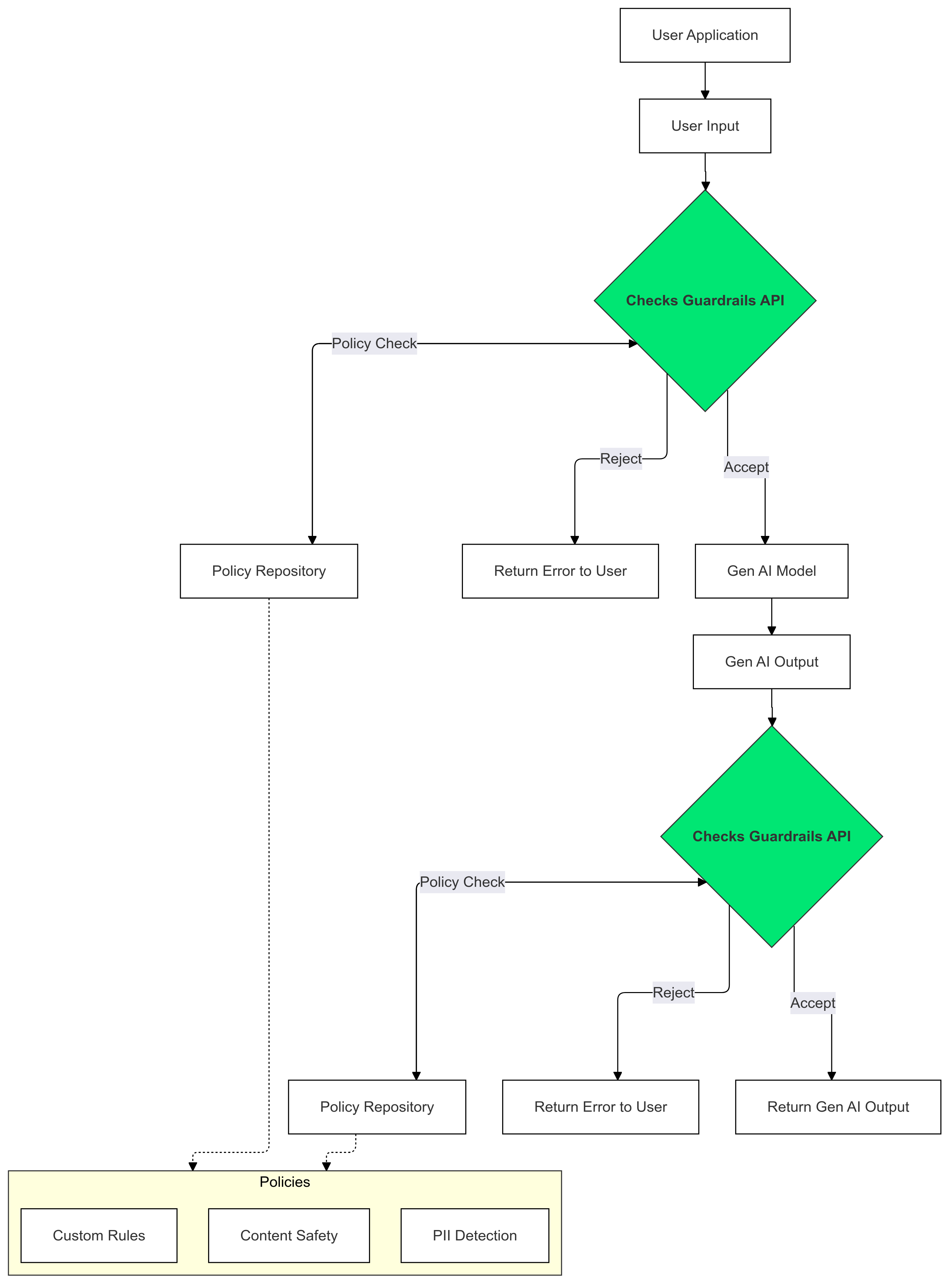Checks Guardrails API พร้อมใช้งานในเวอร์ชันอัลฟ่าในเวอร์ชันตัวอย่างส่วนตัวแล้ว ขอสิทธิ์เข้าถึงเวอร์ชันตัวอย่างแบบส่วนตัวโดยใช้แบบฟอร์มแสดงความสนใจ
Guardrails API เป็น API ที่ช่วยให้คุณตรวจสอบได้ว่าข้อความอาจเป็นอันตรายหรือไม่ปลอดภัยหรือไม่ คุณสามารถใช้ API นี้ในแอปพลิเคชัน GenAI เพื่อป้องกันไม่ให้ ผู้ใช้เห็นเนื้อหาที่อาจเป็นอันตราย
วิธีใช้การป้องกัน
ใช้แนวทางป้องกันการตรวจสอบกับอินพุตและเอาต์พุตของ Gen AI เพื่อตรวจหาและลด การมีอยู่ของข้อความที่ละเมิดนโยบาย

เหตุใดจึงควรใช้การควบคุม
บางครั้ง LLM อาจสร้างเนื้อหาที่อาจเป็นอันตรายหรือไม่เหมาะสม การผสานรวม Guardrails API เข้ากับแอปพลิเคชัน GenAI เป็นสิ่งสำคัญอย่างยิ่งในการ รับประกันการใช้โมเดลภาษาขนาดใหญ่ (LLM) อย่างมีความรับผิดชอบและปลอดภัยยิ่งขึ้น โดยจะช่วยลดความเสี่ยงที่เกี่ยวข้องกับเนื้อหาที่สร้างขึ้นด้วยการกรองผลลัพธ์ที่อาจเป็นอันตรายในวงกว้าง ซึ่งรวมถึงภาษาที่ไม่เหมาะสม ข้อสังเกตที่เลือกปฏิบัติ และเนื้อหาที่อาจก่อให้เกิดอันตราย ซึ่งไม่เพียงปกป้องผู้ใช้ของคุณ แต่ยังช่วยรักษาชื่อเสียงของแอปพลิเคชันและ เสริมสร้างความไว้วางใจในหมู่ผู้ชมด้วย การให้ความสำคัญกับความปลอดภัยและความรับผิดชอบ Guardrails ช่วยให้คุณสร้างแอปพลิเคชัน GenAI ที่ทั้งเป็นนวัตกรรม และปลอดภัยยิ่งขึ้น
เริ่มต้นใช้งาน
คู่มือนี้จะแสดงวิธีการใช้ Guardrails API เพื่อตรวจหาและ กรองเนื้อหาที่ไม่เหมาะสมในแอปพลิเคชันของคุณ API มี นโยบายที่ผ่านการฝึกมาก่อนหลากหลายรูปแบบซึ่งสามารถระบุเนื้อหาประเภทต่างๆ ที่อาจเป็นอันตราย เช่น วาจาสร้างความเกลียดชัง ความรุนแรง และเนื้อหาเกี่ยวกับเรื่องเพศอย่างโจ่งแจ้ง นอกจากนี้ คุณยังปรับแต่งลักษณะการทำงานของ API ได้โดยการตั้งค่าเกณฑ์สำหรับแต่ละนโยบาย
ข้อกำหนดเบื้องต้น
- ได้รับการอนุมัติโปรเจ็กต์ Google Cloud สำหรับการแสดงตัวอย่างแบบส่วนตัวของ Checks AI Safety หากยังไม่ได้ขอสิทธิ์เข้าถึง ให้ขอสิทธิ์โดยใช้แบบฟอร์มแสดงความสนใจ
- เปิดใช้ Checks API
- ตรวจสอบว่าคุณส่งคำขอที่ได้รับอนุญาตได้โดยใช้คำแนะนำเกี่ยวกับการให้สิทธิ์
นโยบายที่รองรับ
| ชื่อนโยบาย | คำอธิบายนโยบาย | ค่า Enum ของ API ประเภทนโยบาย |
|---|---|---|
| เนื้อหาที่ไม่ปลอดภัย | เนื้อหาที่อำนวยความสะดวก ส่งเสริม หรือเปิดให้เข้าถึงสินค้า บริการ และกิจกรรมที่เป็นอันตราย | DANGEROUS_CONTENT |
| การขอและท่อง PII | เนื้อหาที่ขอหรือเปิดเผยข้อมูลส่วนบุคคลหรือข้อมูลที่มีความละเอียดอ่อนของบุคคล | PII_SOLICITING_RECITING |
| การล่วงละเมิด | เนื้อหาที่เป็นอันตราย ข่มขู่ กลั่นแกล้ง หรือละเมิดต่อบุคคลอื่น | HARASSMENT |
| เกี่ยวกับเรื่องเพศอย่างโจ่งแจ้ง | เนื้อหาที่มีลักษณะเกี่ยวกับเรื่องเพศอย่างโจ่งแจ้ง | SEXUALLY_EXPLICIT |
| วาจาสร้างความเกลียดชัง | เนื้อหาที่โดยทั่วไปถือเป็นวาจาสร้างความเกลียดชัง | HATE_SPEECH |
| ข้อมูลทางการแพทย์ | ไม่อนุญาตให้แสดงเนื้อหาที่สนับสนุน ส่งเสริม หรือเปิดโอกาสให้เข้าถึงคำแนะนำหรือคำชี้แนะทางการแพทย์ที่เป็นอันตราย | MEDICAL_INFO |
| ความรุนแรงและเนื้อหาน่าหวาดกลัว | เนื้อหาที่มีคำอธิบายความรุนแรงและ/หรือภาพคราบเลือดที่สมจริงโดยไม่มีเหตุอันควร | VIOLENCE_AND_GORE |
| ลามกอนาจารและหยาบคาย | เราไม่อนุญาตให้แสดงเนื้อหาที่มีภาษาหยาบคาย หยาบโลน หรือไม่เหมาะสม | OBSCENITY_AND_PROFANITY |
ข้อมูลโค้ด
Python
ติดตั้งไคลเอ็นต์ Python ของ Google API โดยเรียกใช้ pip install
google-api-python-client
import logging
from google.oauth2 import service_account
from googleapiclient.discovery import build
SECRET_FILE_PATH = 'path/to/your/secret.json'
credentials = service_account.Credentials.from_service_account_file(
SECRET_FILE_PATH, scopes=['https://www.googleapis.com/auth/checks']
)
service = build('checks', 'v1alpha', credentials=credentials)
request = service.aisafety().classifyContent(
body={
'input': {
'textInput': {
'content': 'Mix, bake, cool, frost, and enjoy.',
'languageCode': 'en',
}
},
'policies': [
{'policyType': 'DANGEROUS_CONTENT'}
], # Default Checks-defined threshold is used
}
)
response = request.execute()
for policy_result in response['policyResults']:
logging.warning(
'Policy: %s, Score: %s, Violation result: %s',
policy_result['policyType'],
policy_result['score'],
policy_result['violationResult'],
)
Go
ติดตั้งไคลเอ็นต์ Go ของ Checks API โดยเรียกใช้
go get google.golang.org/api/checks/v1alpha
package main
import (
"context"
"log/slog"
checks "google.golang.org/api/checks/v1alpha"
option "google.golang.org/api/option"
)
const credsFilePath = "path/to/your/secret.json"
func main() {
ctx := context.Background()
checksService, err := checks.NewService(
ctx,
option.WithEndpoint("https://checks.googleapis.com"),
option.WithCredentialsFile(credsFilePath),
option.WithScopes("https://www.googleapis.com/auth/checks"),
)
if err != nil {
// Handle error
}
req := &checks.GoogleChecksAisafetyV1alphaClassifyContentRequest{
Input: &checks.GoogleChecksAisafetyV1alphaClassifyContentRequestInputContent{
TextInput: &checks.GoogleChecksAisafetyV1alphaTextInput{
Content: "Mix, bake, cool, frost, and enjoy.",
LanguageCode: "en",
},
},
Policies: []*checks.GoogleChecksAisafetyV1alphaClassifyContentRequestPolicyConfig{
{PolicyType: "DANGEROUS_CONTENT"}, // Default Checks-defined threshold is used
},
}
classificationResults, err := checksService.Aisafety.ClassifyContent(req).Do()
if err != nil {
// Handle error
}
for _, policy := range classificationResults.PolicyResults {
slog.Info("Checks Guardrails violation: ", "Policy", policy.PolicyType, "Score", policy.Score, "Violation Result", policy.ViolationResult)
}
}
REST
หมายเหตุ: ตัวอย่างนี้ใช้oauth2l เครื่องมือ CLI
แทนที่ YOUR_GCP_PROJECT_ID ด้วยรหัสโปรเจ็กต์ Google Cloud ที่ได้รับสิทธิ์เข้าถึง Guardrails API
curl -X POST https://checks.googleapis.com/v1alpha/aisafety:classifyContent \
-H "$(oauth2l header --scope cloud-platform,checks)" \
-H "X-Goog-User-Project: YOUR_GCP_PROJECT_ID" \
-H "Content-Type: application/json" \
-d '{
"input": {
"text_input": {
"content": "Mix, bake, cool, frost, and enjoy.",
"language_code": "en"
}
},
"policies": [
{
"policy_type": "HARASSMENT",
"threshold": "0.5"
},
{
"policy_type": "DANGEROUS_CONTENT",
},
]
}'
ตัวอย่างการตอบกลับ
{
"policyResults": [
{
"policyType": "HARASSMENT",
"score": 0.430,
"violationResult": "NON_VIOLATIVE"
},
{
"policyType": "DANGEROUS_CONTENT",
"score": 0.764,
"violationResult": "VIOLATIVE"
},
{
"policyType": "OBSCENITY_AND_PROFANITY",
"score": 0.876,
"violationResult": "VIOLATIVE"
},
{
"policyType": "SEXUALLY_EXPLICIT",
"score": 0.197,
"violationResult": "NON_VIOLATIVE"
},
{
"policyType": "HATE_SPEECH",
"score": 0.45,
"violationResult": "NON_VIOLATIVE"
},
{
"policyType": "MEDICAL_INFO",
"score": 0.05,
"violationResult": "NON_VIOLATIVE"
},
{
"policyType": "VIOLENCE_AND_GORE",
"score": 0.964,
"violationResult": "VIOLATIVE"
},
{
"policyType": "PII_SOLICITING_RECITING",
"score": 0.0009,
"violationResult": "NON_VIOLATIVE"
}
]
}
กรณีการใช้งาน
คุณสามารถผสานรวม Guardrails API เข้ากับแอปพลิเคชัน LLM ได้หลายวิธี โดยขึ้นอยู่กับความต้องการเฉพาะและความเสี่ยงที่ยอมรับได้ ตัวอย่างกรณีการใช้งานที่พบบ่อยมีดังนี้
ไม่มีการแทรกแซงโดยใช้แนวทาง - การบันทึก
ในกรณีนี้ ระบบจะใช้ Guardrails API โดยไม่มีการเปลี่ยนแปลงลักษณะการทำงานของแอป อย่างไรก็ตาม ระบบจะบันทึกการละเมิดนโยบายที่อาจเกิดขึ้นเพื่อวัตถุประสงค์ในการตรวจสอบ และการตรวจสอบ นอกจากนี้ยังสามารถใช้ข้อมูลนี้เพื่อระบุ ความเสี่ยงด้านความปลอดภัยที่อาจเกิดขึ้นกับ LLM ได้อีกด้วย
Python
import logging
from google.oauth2 import service_account
from googleapiclient.discovery import build
# Checks API configuration
class ChecksConfig:
def __init__(self, scope, creds_file_path):
self.scope = scope
self.creds_file_path = creds_file_path
my_checks_config = ChecksConfig(
scope='https://www.googleapis.com/auth/checks',
creds_file_path='path/to/your/secret.json',
)
def new_checks_service(config):
"""Creates a new Checks API service."""
credentials = service_account.Credentials.from_service_account_file(
config.creds_file_path, scopes=[config.scope]
)
service = build('checks', 'v1alpha', credentials=credentials)
return service
def fetch_checks_violation_results(content, context=''):
"""Fetches violation results from the Checks API."""
service = new_checks_service(my_checks_config)
request = service.aisafety().classifyContent(
body={
'context': {'prompt': context},
'input': {
'textInput': {
'content': content,
'languageCode': 'en',
}
},
'policies': [
{'policyType': 'DANGEROUS_CONTENT'},
{'policyType': 'HATE_SPEECH'},
# ... add more policies
],
}
)
response = request.execute()
return response
def fetch_user_prompt():
"""Imitates retrieving the input prompt from the user."""
return 'How do I bake a cake?'
def fetch_llm_response(prompt):
"""Imitates the call to an LLM endpoint."""
return 'Mix, bake, cool, frost, enjoy.'
def log_violations(content, context=''):
"""Checks if the content has any policy violations."""
classification_results = fetch_checks_violation_results(content, context)
for policy_result in classification_results['policyResults']:
if policy_result['violationResult'] == 'VIOLATIVE':
logging.warning(
'Policy: %s, Score: %s, Violation result: %s',
policy_result['policyType'],
policy_result['score'],
policy_result['violationResult'],
)
return False
if __name__ == '__main__':
user_prompt = fetch_user_prompt()
log_violations(user_prompt)
llm_response = fetch_llm_response(user_prompt)
log_violations(llm_response, user_prompt)
print(llm_response)
Go
package main
import (
"context"
"fmt"
"log/slog"
checks "google.golang.org/api/checks/v1alpha"
option "google.golang.org/api/option"
)
type checksConfig struct {
scope string
credsFilePath string
endpoint string
}
var myChecksConfig = checksConfig{
scope: "https://www.googleapis.com/auth/checks",
credsFilePath: "path/to/your/secret.json",
endpoint: "https://checks.googleapis.com",
}
func newChecksService(ctx context.Context, cfg checksConfig) (*checks.Service, error) {
return checks.NewService(
ctx,
option.WithEndpoint(cfg.endpoint),
option.WithCredentialsFile(cfg.credsFilePath),
option.WithScopes(cfg.scope),
)
}
func fetchChecksViolationResults(ctx context.Context, content string, context string) (*checks.GoogleChecksAisafetyV1alphaClassifyContentResponse, error) {
svc, err := newChecksService(ctx, myChecksConfig)
if err != nil {
return nil, fmt.Errorf("failed to create checks service: %w", err)
}
req := &checks.GoogleChecksAisafetyV1alphaClassifyContentRequest{
Context: &checks.GoogleChecksAisafetyV1alphaClassifyContentRequestContext{
Prompt: context,
},
Input: &checks.GoogleChecksAisafetyV1alphaClassifyContentRequestInputContent{
TextInput: &checks.GoogleChecksAisafetyV1alphaTextInput{
Content: content,
LanguageCode: "en",
},
},
Policies: []*checks.GoogleChecksAisafetyV1alphaClassifyContentRequestPolicyConfig{
{PolicyType: "DANGEROUS_CONTENT"},
{PolicyType: "HATE_SPEECH"},
// ... add more policies
},
}
response, err := svc.Aisafety.ClassifyContent(req).Do()
if err != nil {
return nil, fmt.Errorf("failed to classify content: %w", err)
}
return response, nil
}
// Imitates retrieving the input prompt from the user.
func fetchUserPrompt() string {
return "How do I bake a cake?"
}
// Imitates the call to an LLM endpoint.
func fetchLLMResponse(prompt string) string {
return "Mix, bake, cool, frost, enjoy."
}
func logViolations(ctx context.Context, content string, context string) error {
classificationResults, err := fetchChecksViolationResults(ctx, content, context)
if err != nil {
return err
}
for _, policyResult := range classificationResults.PolicyResults {
if policyResult.ViolationResult == "VIOLATIVE" {
slog.Warn("Checks Guardrails violation: ", "Policy", policyResult.PolicyType, "Score", policyResult.Score, "Violation Result", policyResult.ViolationResult)
}
}
return nil
}
func main() {
ctx := context.Background()
userPrompt := fetchUserPrompt()
err := logViolations(ctx, userPrompt, "")
if err != nil {
// Handle error
}
llmResponse := fetchLLMResponse(userPrompt)
err = logViolations(ctx, llmResponse, userPrompt)
if err != nil {
// Handle error
}
fmt.Println(llmResponse)
}
การป้องกันไม่ให้เกิดการละเมิดถูกบล็อกตามนโยบาย
ในตัวอย่างนี้ Guardrails API จะบล็อกอินพุตของผู้ใช้และคำตอบของโมเดลที่ไม่ปลอดภัย โดยจะตรวจสอบทั้ง 2 อย่างกับนโยบายด้านความปลอดภัยที่กำหนดไว้ล่วงหน้า (เช่น วาจาสร้างความเกลียดชัง เนื้อหาที่เป็นอันตราย) ซึ่งจะช่วยป้องกันไม่ให้ AI สร้างเอาต์พุตที่อาจเป็นอันตรายและ ปกป้องผู้ใช้จากการพบเนื้อหาที่ไม่เหมาะสม
Python
from google.oauth2 import service_account
from googleapiclient.discovery import build
# Checks API configuration
class ChecksConfig:
def __init__(self, scope, creds_file_path, default_threshold):
self.scope = scope
self.creds_file_path = creds_file_path
self.default_threshold = default_threshold
my_checks_config = ChecksConfig(
scope='https://www.googleapis.com/auth/checks',
creds_file_path='path/to/your/secret.json',
default_threshold=0.6,
)
def new_checks_service(config):
"""Creates a new Checks API service."""
credentials = service_account.Credentials.from_service_account_file(
config.creds_file_path, scopes=[config.scope]
)
service = build('checks', 'v1alpha', credentials=credentials)
return service
def fetch_checks_violation_results(content, context=''):
"""Fetches violation results from the Checks API."""
service = new_checks_service(my_checks_config)
request = service.aisafety().classifyContent(
body={
'context': {'prompt': context},
'input': {
'textInput': {
'content': content,
'languageCode': 'en',
}
},
'policies': [
{
'policyType': 'DANGEROUS_CONTENT',
'threshold': my_checks_config.default_threshold,
},
{'policyType': 'HATE_SPEECH'},
# ... add more policies
],
}
)
response = request.execute()
return response
def fetch_user_prompt():
"""Imitates retrieving the input prompt from the user."""
return 'How do I bake a cake?'
def fetch_llm_response(prompt):
"""Imitates the call to an LLM endpoint."""
return 'Mix, bake, cool, frost, enjoy.'
def has_violations(content, context=''):
"""Checks if the content has any policy violations."""
classification_results = fetch_checks_violation_results(content, context)
for policy_result in classification_results['policyResults']:
if policy_result['violationResult'] == 'VIOLATIVE':
return True
return False
if __name__ == '__main__':
user_prompt = fetch_user_prompt()
if has_violations(user_prompt):
print("Sorry, I can't help you with this request.")
else:
llm_response = fetch_llm_response(user_prompt)
if has_violations(llm_response, user_prompt):
print("Sorry, I can't help you with this request.")
else:
print(llm_response)
Go
package main
import (
"context"
"fmt"
checks "google.golang.org/api/checks/v1alpha"
option "google.golang.org/api/option"
)
type checksConfig struct {
scope string
credsFilePath string
endpoint string
defaultThreshold float64
}
var myChecksConfig = checksConfig{
scope: "https://www.googleapis.com/auth/checks",
credsFilePath: "path/to/your/secret.json",
endpoint: "https://checks.googleapis.com",
defaultThreshold: 0.6,
}
func newChecksService(ctx context.Context, cfg checksConfig) (*checks.Service, error) {
return checks.NewService(
ctx,
option.WithEndpoint(cfg.endpoint),
option.WithCredentialsFile(cfg.credsFilePath),
option.WithScopes(cfg.scope),
)
}
func fetchChecksViolationResults(ctx context.Context, content string, context string) (*checks.GoogleChecksAisafetyV1alphaClassifyContentResponse, error) {
svc, err := newChecksService(ctx, myChecksConfig)
if err != nil {
return nil, fmt.Errorf("failed to create checks service: %w", err)
}
req := &checks.GoogleChecksAisafetyV1alphaClassifyContentRequest{
Context: &checks.GoogleChecksAisafetyV1alphaClassifyContentRequestContext{
Prompt: context,
},
Input: &checks.GoogleChecksAisafetyV1alphaClassifyContentRequestInputContent{
TextInput: &checks.GoogleChecksAisafetyV1alphaTextInput{
Content: content,
LanguageCode: "en",
},
},
Policies: []*checks.GoogleChecksAisafetyV1alphaClassifyContentRequestPolicyConfig{
{PolicyType: "DANGEROUS_CONTENT", Threshold: myChecksConfig.defaultThreshold},
{PolicyType: "HATE_SPEECH"}, // default Checks-defined threshold is used
// ... add more policies
},
}
response, err := svc.Aisafety.ClassifyContent(req).Do()
if err != nil {
return nil, fmt.Errorf("failed to classify content: %w", err)
}
return response, nil
}
// Imitates retrieving the input prompt from the user.
func fetchUserPrompt() string {
return "How do I bake a cake?"
}
// Imitates the call to an LLM endpoint.
func fetchLLMResponse(prompt string) string {
return "Mix, bake, cool, frost, enjoy."
}
func hasViolations(ctx context.Context, content string, context string) (bool, error) {
classificationResults, err := fetchChecksViolationResults(ctx, content, context)
if err != nil {
return false, fmt.Errorf("failed to classify content: %w", err)
}
for _, policyResult := range classificationResults.PolicyResults {
if policyResult.ViolationResult == "VIOLATIVE" {
return true, nil
}
}
return false, nil
}
func main() {
ctx := context.Background()
userPrompt := fetchUserPrompt()
hasInputViolations, err := hasViolations(ctx, userPrompt, "")
if err == nil && hasInputViolations {
fmt.Println("Sorry, I can't help you with this request.")
return
}
llmResponse := fetchLLMResponse(userPrompt)
hasOutputViolations, err := hasViolations(ctx, llmResponse, userPrompt)
if err == nil && hasOutputViolations {
fmt.Println("Sorry, I can't help you with this request.")
return
}
fmt.Println(llmResponse)
}
สตรีมเอาต์พุต LLM ไปยัง Guardrails
ในตัวอย่างต่อไปนี้ เราจะสตรีมเอาต์พุตจาก LLM ไปยัง Guardrails API ซึ่งใช้เพื่อลดเวลาในการตอบสนองที่ผู้ใช้รับรู้ได้ แนวทางนี้อาจทำให้เกิดผลลบลวงเนื่องจากบริบทไม่สมบูรณ์ ดังนั้นเอาต์พุตของ LLM จึงต้องมีบริบทเพียงพอเพื่อให้ Guardrails ประเมินได้อย่างถูกต้องก่อนที่จะเรียกใช้ API
การเรียกใช้ขอบเขตแบบซิงโครนัส
Python
if __name__ == '__main__':
user_prompt = fetch_user_prompt()
my_llm_model = MockModel(
user_prompt, fetch_llm_response(user_prompt)
)
llm_response = ""
chunk = ""
# Minimum number of LLM chunks needed before we will call Guardrails.
contextThreshold = 2
while not my_llm_model.finished:
chunk = my_llm_model.next_chunk()
llm_response += str(chunk)
if my_llm_model.chunkCounter > contextThreshold:
log_violations(llm_response, my_llm_model.userPrompt)
Go
func main() {
ctx := context.Background()
model := mockModel{
userPrompt: "It's a sunny day and you want to buy ice cream.",
response: []string{"What a lovely day", "to get some ice cream.", "is the shop open?"},
}
// Minimum number of LLM chunks needed before we will call Guardrails.
const contextThreshold = 2
var llmResponse string
for !model.finished {
chunk := model.nextChunk()
llmResponse += chunk + " "
if model.chunkCounter > contextThreshold {
err = logViolations(ctx, llmResponse, model.userPrompt)
if err != nil {
// Handle error
}
}
}
}
การเรียกใช้ขอบเขตแบบอะซิงโครนัส
Python
async def main():
user_prompt = fetch_user_prompt()
my_llm_model = MockModel(
user_prompt, fetch_llm_response(user_prompt)
)
llm_response = ""
chunk = ""
# Minimum number of LLM chunks needed before we will call Guardrails.
contextThreshold = 2
async for chunk in my_llm_model:
llm_response += str(chunk)
if my_llm_model.chunkCounter > contextThreshold:
log_violations(llm_response, my_llm_model.userPrompt)
asyncio.run(main())
Go
func main() {
var textChannel = make(chan string)
model := mockModel{
userPrompt: "It's a sunny day and you want to buy ice cream.",
response: []string{"What a lovely day", "to get some ice cream.", "is the shop open?"},
}
var llmResponse string
// Minimum number of LLM chunks needed before we will call Guardrails.
const contextThreshold = 2
go model.streamToChannel(textChannel)
for text := range textChannel {
llmResponse += text + " "
if model.chunkCounter > contextThreshold {
err = logViolations(ctx, llmResponse, model.userPrompt)
if err != nil {
// Handle error
}
}
}
}
คำถามที่พบบ่อย
ฉันควรทำอย่างไรหากใช้ API ของ Guardrails จนถึงโควต้าที่กำหนดแล้ว
หากต้องการขอเพิ่มโควต้า ให้ส่งอีเมลคำขอไปที่ checks-support@google.com โปรดระบุข้อมูลต่อไปนี้ในอีเมล
- หมายเลขโปรเจ็กต์ Google Cloud: หมายเลขนี้ช่วยให้เราระบุบัญชีของคุณได้อย่างรวดเร็ว
- รายละเอียดเกี่ยวกับกรณีการใช้งาน: อธิบายวิธีที่คุณใช้ Guardrails API
- จำนวนโควต้าที่ต้องการ: ระบุจำนวนโควต้าเพิ่มเติมที่คุณต้องการ

